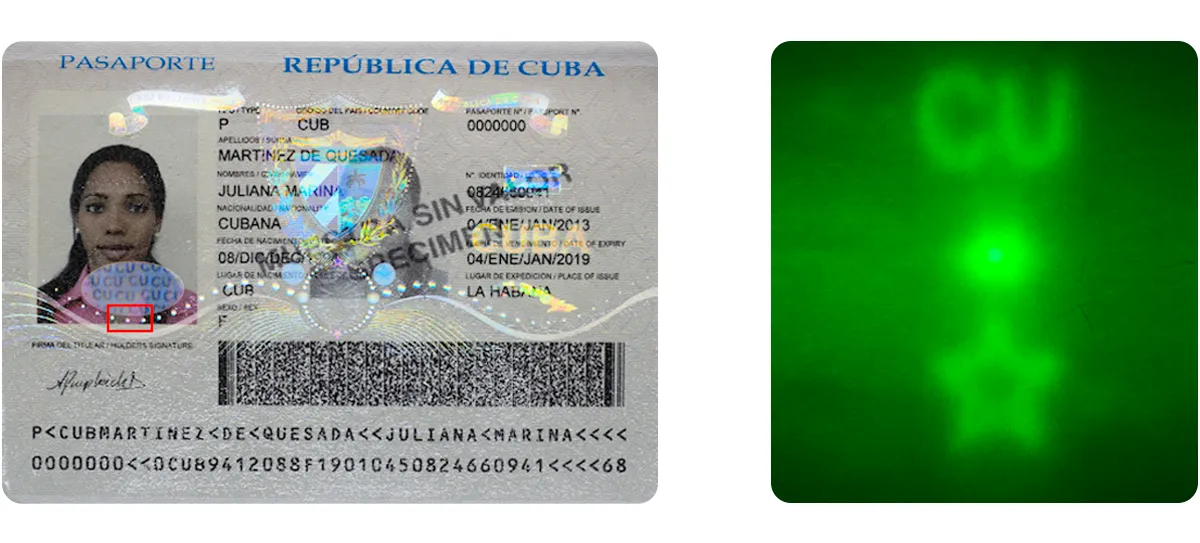Can a security feature in a document secure another security feature in a document?
Spoiler: it can.
There are plenty of examples, but the most curious one is probably a covert image in a hologram visible only in laser light. One might think that a hologram is already counterfeit-proof enough. However, these invisible laser readable images are hardly overkill when it comes to securing an identity document or a banknote, taking into consideration the plethora of tampering techniques fraudsters use nowadays.
Let’s dive in and learn what covert laser readable (CLR) images look like, how they help to prevent fraud, how they are made, where to find and how to verify them, and how Regula can help all along the way.
We’ll deliver hand-picked content from Regula’s experts into your inbox
What is a covert laser readable image?
Сovert laser readable images are really hidden. They are invisible to the naked eye and a microscope, and one must know exactly where to search for them. You can scrutinize a hologram down to the tiniest detail with all types of optical devices, but if it contains a covert laser readable image, it will elude you without special equipment.
The only way to visualize CLR images is to use laser light directed perpendicularly to the surface of a hologram. However, a simple beam of light won’t show any image: you’ll need it to be reflected and shown on a screen. In other words, a CLR image will never be seen directly on the surface of an identity document or a banknote.
Apart from being covert, CLR images are also tiny. They comprise 1 micron in size and less than 1 micron in the depth of the hologram area.
The peculiarity of CLR images is that they are formed in the process of creating holograms with the electron-beam lithography method. Since they aren't added before or after the hologram is created, CLR images are an integral part of the process, and thus fraud-resilient. Even if a counterfeiter attempts to forge a hologram image (which is also hardly feasible), they won’t be able to forge a CLR image, since it has a specific microrelief that matches the hologram’s physical structure. That is why these images reliably help prevent fraud with identity documents.
You might also like 6 Rare Document Security Features & How to Examine Them
Some real-world examples of CLR images
Covert laser readable images emerged in the mid-1990s. Since then, they have become quite common in passports, ID cards, banknotes, and other documents that contain holograms.
For instance, a CLR image is hidden in the hologram of the 20-euro banknote released in 2015. It’s in the lower right, and if you direct a laser beam on the selected area (see the illustration), you’ll be able to see the number 20 reflected in green light.

ID cards also employ CLR images for security reasons. For example, you can find one in a Moldovan ID Card issued in 2014: the covert image is the inscription “MDA,” and it is placed in the lower part of the hologram that secures the portrait.

Many countries add CLR images in the holograms that are meant to protect passports from forgery. For instance, a Cuban passport from the year 2013 can perfectly demonstrate the implementation of a CLR image in a hologram. With a laser beam, you’ll see the letters “CU” and a star hidden in the lower central part of the hologram placed over the portrait.

Also, a Danish passport issued in 2021 contains a CLR image in a different place. For the majority of passports, it’s typical to inject covert images in holograms that are placed on the pages with the holder’s personal data. Unlike them, a Danish passport hides such an image on the back side of the data page in a long hologram stripe. The reflected laser light will reveal a double set of letters: “DK”.

Solutions to verify CLR images
CRL images are tricky. On the one hand, they are a super reliable security feature; on the other hand, detecting them requires both in-depth knowledge of numerous documents, as well as special tools. And that is why you need Regula.
To help visualize covert laser readable images in holograms, we developed a special compact device, Regula 2305.

Comparable in size to a modern smartphone, this visualizer is a handy and efficient tool that instantly reveals hidden images in holograms. It has two laser light sources, green (532 nm) and red (650 nm), and can illuminate holograms at any angle in the range of 70°–110°. Its screen is transparent to facilitate searching for a CLR image. Once found, the CLR image is captured by a laser beam and projected onto the device screen, which immediately loses its transparency.
As for the knowledge required to search for CLR images, it can be obtained with Regula solutions too. We have five Information Reference Systems (IRSs), extensive databases of travel documents, banknotes, driver's licenses, and vehicle registration certificates. Each of these databases provides a detailed description of every item so that the person responsible for verification has a credible source of information to prove the genuineness of documents.
If any hologram in any document contains a CLR image, you’ll definitely know it from our database. Moreover, judging from our market analysis, Regula’s IRS is probably the only source of information on CLR images in the industry.





